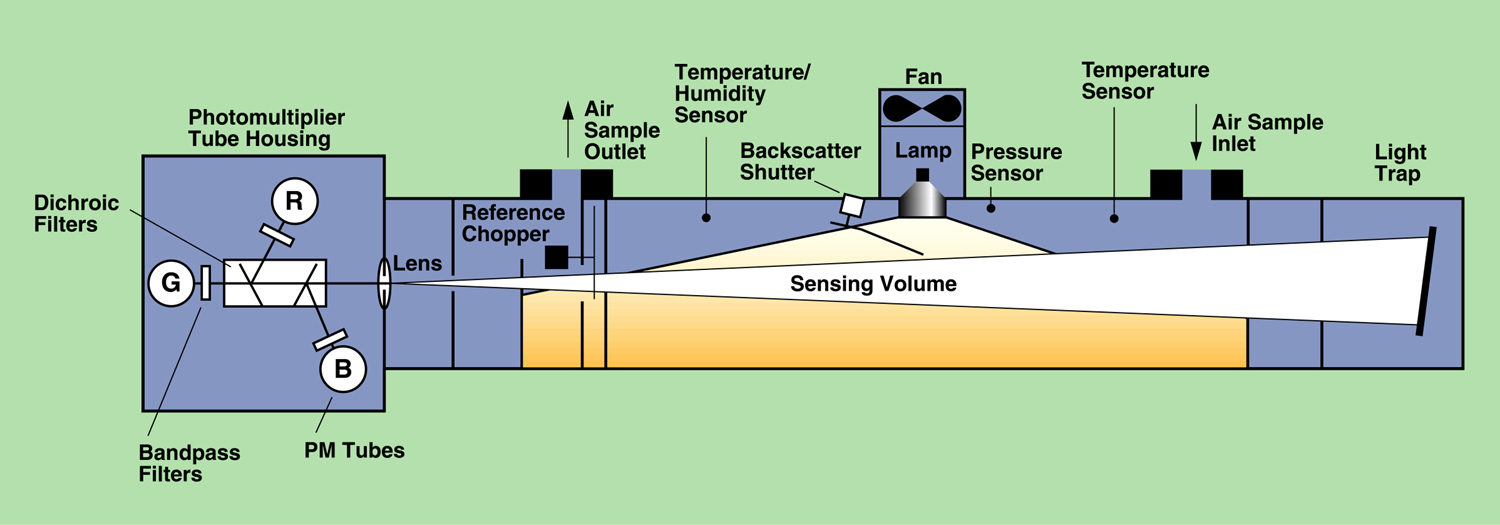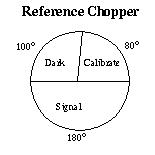Aerosol Instrumentation - Nephelometer
Three Wavelength Integrating Nephelometer
(This page originally created for Prof. Lynn Russell at Princeton University by Alan Mizrahi.)
The nephelometer is an instrument that measures aerosol light scattering. It detects scattering properties by measuring light scattered by the aerosol and subtracting light scattered by the gas, the walls of the instrument and the background noise in the detector. The three-wavelength model (TSI 3563) splits the scattered light into red (700 nm), green (550 nm), and blue (450 nm) wavelengths. The TSI neph measures back-scattered light at these wavelengths as well. The one wavelength Radiance Research nephelometer measures forward scattering at 550 nm only. The TSI and the Radiance Research neph are no longer in production so some sites in the NFAN network are now using Ecotech Aurora 3000 nephelometers.
Photos of TSI 3563 Nephelometer
Design Features

The main body of the TSI 3563 nephelometer is a 10 cm diameter aluminum tube, 90 cm long. Along the axis is an 8 cm diameter tube set with aperture plates. The plates range from 7 - 170o on the horizontal range of the lamp. The backscatter shutter allows blocking of the angles from 7 - 90o so that only backscattering is measured. The light trap provides a dark reference against which to measure the scattered light.
The receiving optics are located on the other side of the tube from the trap. The light that passes through the lens is separated by dichroic filters into three wavelengths. The first is a color splitter that passes 500-800 nm light and reflects 400-500 nm light. The reflected light passes through a filter centered at 450 nm (blue) into a photomultiplier tube (PMT). The light that passes through the first splitter goes to a second splitter which passes 500-600 nm light and reflects 600-800 nm light. The reflected light passes through a filter centered at 700 nm (red) into a second PMT. The light that passes through both splitters passes through a filter centered at 550 nm (green) into a third PMT.
The reference chopper, shown below, is used for calibration of the nephelometer. It consists of three zones. The signal zone allows light to pass through unaltered. The dark zone allows no light to pass, and is used to measure the background noise of the instrument. The calibrate zone allows approximately 0.1% of the light to pass and is used to measure lamp stability over time. The chopper rotates 23 times per second.

Theory of Operation
The property that the nephelometer measures is the extinction of light over a distance. Extinction is caused by both scattering and absorption of light by particles. The extinction coeffiecient bext is a measure of these, and is given by the formula
bext = bscat + babs = ln(I/I0)/x
x = length of light path
I = intensity of light after distance
I0 = initial intensity of light
bscat and babs are the scattering and absorption coefficients.
They are each divided into two components.
bscat = brg + bsp
babs = bag + bap
brg = Rayleigh (gas) scattering coefficient
bsp = particle scattering coefficient
bag = gas absorption coefficient
bap = particle absorption coefficient
The nephelometer measures bscat and brg and subtracts to get bsp. bag is usually negligible. The equation derived by Middleton (1958) and Butcher and Charlson (1972) that governs the instrument is
B = (I0/y)*(bscat/2PI)
y = vertical distance from light source to sensor
B = flux of light detected by sensor
The nephelometer counts photons using the photomultiplier tubes. The photon counts are converted to counting frequencies and then scattering coefficients usuing calibration constants. This is desribed in detail in the 'Signal Processing' section. The instrument is calibrated using two "span gases" with different known scattering properties. This is described in detail in the 'Calibration' section.
Signal Processing
The process decsribed in this section is carried out for each of the three colors.
First, the raw photon count for each section (or gate) of the reference chopper is measured for total scatter and backscatter. There are a total of 18 data (3 colors x 3 chopper sections x 2 positions of backscatter shutter). These data are normalized by gate width to get a scaled count rate according to the equation
Cs = (360*C*S)/(G*N)
C = raw photon count
S = speed of chopper (Hz)
G = gate width (degrees)
N = number of revolutions
Cs = scaled count rate (Hz)
Note: The gate width is 40o less than the total section width. The first and last 20o are blank to separate the signals.
When a pulse of light is being registerd on the PMT, it cannot register another pulse during that time. This "dead time" is a function of the pulse width of the PMT and must be corrected for using the equation
F = Cs*(Cs*K1 + 1)
K1 = pulse width constant
F = corrected count rate (Hz)
From time to time, the air sample entering the nephelometer is filtered in order to measure the scattering by the gas molecules. The nephelometer calculates raw scattering signals for filtered air and for aerosol.
Bf = K2*(Sf - Df)/(Cf - Df)
K2 = span gas constant
Sf = scaled count rate of signal gate for filtered air (Hz)
Df = scaled count rate of dark gate for filtered air (Hz)
Cf = scaled count rate of calibrate gate for filtered air (Hz)
Bf = raw scatter signal for filtered air.
The same is done for the aerosol ('a' subscripts).
The Rayleigh scattering for filtered air and aerosol is then calculated.
Rf = (K3*Pf*Ts)/(Tf*Ps)
K3 = Rayleigh scatter constant
Pf = Pressure of filtered air
Ts = Standard temperature (273.15 K)
Tf = Temperature of filtered air
Ps = Standard pressure (1.0133 bar)
Rf = Rayleigh scatter for filtered air
The same is done for the aerosol.
Three parameters are then calculated: wall scatter (W), total scatter (Bs), and bsp.
W = Bf - Rf
Bs = Ba - W
bsp = Bs - Ra
In order to calculate the backscatter coefficient (bbsp), the same procedure is followed, and K3 is multiplied by K4, a backscatter constant.
The instrument error is +/- 0.2 mm-1
Calibration
K1 is based on the pulse width of the PMT and is set by the manufacturer. It is different for each color.
K3 is a known property of air and varies with wavelength, temperature and pressure. K3 values for the span gases are also known.
K2 is calculated from the scattering data of two span gases, 'low' and 'high.' The scattering coefficient for the low span gas is expanded to
bspl = Bl - W - Rl = K2*(Sl - Dl)/(Cl - Dl) - K3l*(Pl/Ps)*(Ts/Tl) - W = 0
The scattering coefficient is 0 because there are no particles present. This equation also holds for the high span gas. The two equations are subtracted from one another. The W term drops out and the only remaining unknown is K2 which can then be solved for.
K4 is likewise calculated using backscatter data. The equation for the low span gas is
bbspl = Bl - W - Rl = K2*(Sl - Dl)/(Cl - Dl) - K4*K3l*(Pl/Ps)*(Ts/Tl) - W = 0
The equation again is applied to the high span gas as well. The two equations are subtracted to eliminate W, and the only remaining unknown is K4.
References
- Anderson, T.L., Covert, D.S., Wheeler, J.D., Harris, J.M., Perry, K.D., Trost, B.E., Jaffe, D.J., and Ogren, J.A., " Aerosol backscatter fraction and single scattering albedo: Measured values and uncertainties at a coastal station in the Pacific Northwest," J. Geophysical Research, 104, 26793-26807, 1999.
- Anderson, T.L., Covert, D.S., Marshalll, S.F., Laucks, M.L, Charlson, R.J., Waggoner, A.P., Ogren, J.A., Caldow, R., Holm, R.L., Quant, F.R., Sem, G.J., Wiedensohler, A., Ahlquist, N.A., and Bates, T.S., "Performance characteristics of a high-sensitivity, three-wavelength total scatter/backscatter nephelometer," J. Atmospheric and Oceanic Technology, 13, 967-986, 1996.
- Anderson,T.L., and Ogren, J.A., "Deteriming aerosol radiative properties using the TSI 3563 Integrating Nephelometer," Aerosol Science and Technology, 29, 57-69, 1998.
- Heintzenberg, J. and Charlson, R.J., "Design and applications of the integrating nephelometer: A review," J. Atmospheric and Oceanic Technology, 13, 987-1000, 1996.
